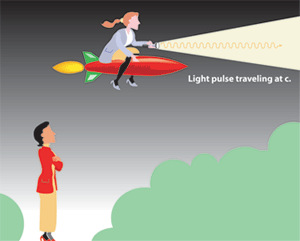Time Travel Research Center © 2005 Cetin BAL - GSM:+90 05366063183 - Turkey / Denizli
What is Relativity?
an
Introduction
In this summary from the eBook Relativity 4 Engineers, the question "what is relativity?" is answered in a non-technical way. The eBook treats the same topic in depth.
The Principles of Special Relativity
Einstein was lead to his special theory of relativity by his believe that there is no way to detect absolute motion. This dictated that the measured speed of light must be the same in all inertial frames of reference. If this was not so, the laws of physics would have been different in inertial frames that move relative to each other.
Inertial frames are uniformly moving coordinate systems, far away from gravitational effects or any other form of influence, where inertia is isotropic, meaning a given force will cause the same acceleration on identical masses in whatever direction the force is applied.
The Aether Abolished
Einstein also argued that if there was a 'rest-frame' for light (the luminiferous aether), we could in principle set up an inertial frame in which light would not propagate in the forward direction at all, e.g., if the frame moves at the speed of light relative to the aether. Einstein was still very young, when he reportedly contemplated if he would still be able to see his own face in a mirror if they were both at rest in such a frame - moving at the speed of light through the aether.

Einstein realized that it is paradoxical to assume the same light ray can actually move with the same speed c (in an absolute Newtonian sense) relative to all inertial frames. This would require that light adapt its "absolute speed" to the frame that measures it. He decided that either time intervals or distance intervals (or both) must change if measured by observers in different inertial frames in relative motion.
The Spacetime Interval
In Newtonian dynamics, space intervals and time intervals are the same for all inertial observers, no matter how fast they move. In Einstein's dynamics, it is the spacetime interval that remains the same for all inertial observers, no matter how fast they move. This concept offers the best answer to the question: "what is relativity?"
The square of the spacetime interval is the difference between the square of the time interval and the square of the distance interval, given that all are expressed in the same units. Time is converted to a distance by multiplying it with the speed of light, e.g., one second represents 300 million meters (the speed of light is 300 million meters per second).
Example
Let us calculate a simple example. Suppose you ride on-board a spaceship that travel from Earth to Alpha Centauri at a speed of 80% of the speed of light. The trip takes 3 years on your calendar. But wait, Alpha Centauri is about 4 light-years from Earth, so how could you possible have reached it in 3 years? To answer the question, consider your spacetime interval between the two events - your departure from Earth and your arrival at Alpha Centauri.

The time interval on your calendar is 3 years. The space interval in your reference frame is zero. How can this be? Well, you were present at both events (departure and arrival), so in your frame of reference, there cannot be a space interval between the two events! So what is the spacetime interval? It must be 3 light-years, because you subtract zero-squared from 3-squared, leaving you with 3-squared.
Solution
Now this spacetime interval must remain constant for all observers, thus also for Earth-bound observers. From Earth, we measured the distance to Alpha Centauri accurately as 4 light-years, which must then be the space interval between your departure from here and your arrival at Alpha Centauri. We know that the spacetime interval is 3 years for everyone, so what time interval does it give us? We take 3-squared and add 4-squared, giving 25. Take the square root and we have the time interval for Earth's inertial frame: 5 years.
So, after all, you did not travel at faster than light! In our reference frame, you traveled at our original assumption of 80% of the speed of light (4 light-years in 5 years). If we, erroneously, take our distance and divide it by your time, we would end up with 4 divided by 3, or a speed of 133% of light-speed. If you insist that you want to know the distance between Earth and Alpha Centauri in your inertial reference frame, you can take your measured speed (0.8c) and multiply it by your measured time interval (3 years) and get a distance of 2.4 light-years.
Time Dilation and Length Contraction
In trying to answer the question "what is relativity?", we have indirectly 'stumbled upon' the phenomena of time dilation and length contraction due to velocity. The constancy (or invariance) of the spacetime interval is underlying to relativistic time dilation and length contraction. With your relative speed of 0.8c, your time dilation factor is 0.6, meaning you will measure times and radial distances that are only 60% of what we on Earth would have measured.
The reason for belaboring the observation of the time- and space-intervals between events is this: events in empty space give us something 'tangible' to base special relativity comparisons between inertial frames upon. It does not say whose clock is running faster or slower than anybody elses, but it does say unequivocally who will measure the shorter time and distance between two events---it the observer who is present at both events.
This answers a big part of the topical question: what is relativity?
You will find more depth in the answer to "what is relativity?" in the first part of chapter 1 of the eBook Relativity 4 Engineers, linked to below.
Einstein's Special Theory of Relativity
In the late 1800s, many scientists were comfortable with the existing description of the universe. In fact, many of them thought physics research was winding down and that all they had left to do was work out the details. The problem was that many of the details were observations or experimental results that couldnt be explained by current theories. One such detail was that experiments always measured the speed of light as 3x10 8 m/s (186,000 miles per second, or mps).
According to everyday experience, it seems that the speed of light should change depending on how fast you are moving. Imagine a car with a For Sale sign in the window going 55 mph.
- A person standing still on the side of the road would see a car flying by and the sign would be a blur.
- A person driving next to the car at 55 mph could look out the window and copy down the phone number from the sign.
- A person going down the road in the opposite direction at 55 mph would zoom by the car and probably not even know the sign was there.
The speed we see things moving at depends on the difference between how fast the other person is going and how fast we are going.
-
 The person standing still sees the car going at 55 mph.
The person standing still sees the car going at 55 mph.
55 mph (sign) 0 mph (person) = 55 mph.
- The person in the car next to the sign sees the car going at 0 mph.
55 mph (sign) 55 mph (car) = 0 mph.
- The person going the opposite way sees the car going at 110 mph.
55 mph (sign) - -55 (car) = 110 mph.
Because of this, scientists assumed that if you measure the speed of light in different directions, you should get different speeds since the earth is in orbit around the sun. In 1895 Albert Michelson and Edward Morley performed this experiment and surprisingly, saw no difference in the speed of light for different directions.
Albert Einstein resolved this puzzle in 1905 by suggesting that unlike the speed of a car, the speed of light is the same no matter how fast the observer is moving. In other words, even if you ran very fast you would not be any closer to catching up with a light wave than someone standing still. The first principle of Einsteins Special Theory of Relativity is that the speed of light is always the same regardless of the motion of the observer or the light source.
Einstein also realized that although people see things differently (for example the speed of the For Sale sign), the laws of physics have to be the same for all observers. Someone riding on a train should be able to do the same experiments and get the same results as someone sitting in a classroom. If this were not true, people would get conflicting answers about how nature behaves depending on their motion but nature does what nature does, it cant follow different predictions depending on who is observing it. Therefore, the second principle of Einsteins Special Theory of Relativity is that the laws of physics do not depend on the motion of the observer as long as the observer is not speeding up or slowing down.
Principles of the Special Theory of Relativity
- The speed of light is always the same regardless of the motion of the observer or the light source.
- The laws of physics do not depend on the motion of the observer as long as the observer is not speeding up or slowing down.
 If
these two principles are true, Einstein showed that motion must affect
distance and time. Imagine two people watching a beam of light. If one
person is standing still, the light will look to her like it is moving
at a speed of 186,000 mps. If the other person is in a spaceship
traveling 100,000 mps, he still sees the light moving at 186,000 mps.
How can this be true? Only if space and time are not absolute.
If
these two principles are true, Einstein showed that motion must affect
distance and time. Imagine two people watching a beam of light. If one
person is standing still, the light will look to her like it is moving
at a speed of 186,000 mps. If the other person is in a spaceship
traveling 100,000 mps, he still sees the light moving at 186,000 mps.
How can this be true? Only if space and time are not absolute.
![]() The
traditional views of space and time were that they were two independent,
fixed quantities. According to Einsteins theory, however, an object in
motion is shorter than when it is at rest. Similarly, a clock in motion
ticks more slowly than a clock at rest. In fact, Einstein concluded that
distance and time are more accurately described as one thing spacetime.
The
traditional views of space and time were that they were two independent,
fixed quantities. According to Einsteins theory, however, an object in
motion is shorter than when it is at rest. Similarly, a clock in motion
ticks more slowly than a clock at rest. In fact, Einstein concluded that
distance and time are more accurately described as one thing spacetime.
We dont notice these strange effects on a day-to-day basis because things on earth move significantly slower than the speed of light, so the effects are tiny. As strange as these ideas sound, scientific evidence has continually supported Einsteins theory.
Hiçbir yazı/ resim izinsiz olarak kullanılamaz!! Telif hakları uyarınca bu bir suçtur..! Tüm hakları Çetin BAL' a aittir. Kaynak gösterilmek şartıyla siteden alıntı yapılabilir.
The Time Machine Project © 2005 Cetin BAL - GSM:+90 05366063183 -Turkiye/Denizli
Ana Sayfa /
index /Roket bilimi /![]() E-Mail /CetinBAL/Quantum Teleportation-2
E-Mail /CetinBAL/Quantum Teleportation-2
Time Travel Technology /Ziyaretçi Defteri /UFO Technology/Duyuru